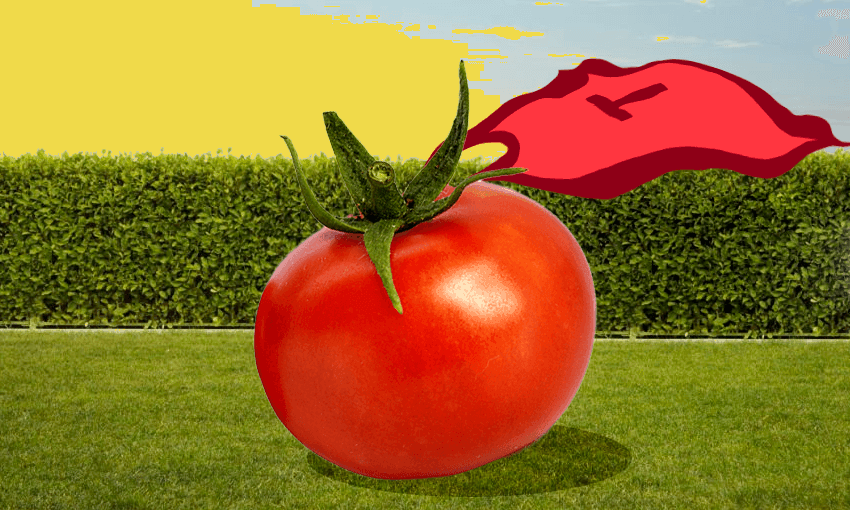The wild and wet summer weather has wreaked havoc in our gardens with bees staying home and beans going mouldy on the vine. As for those precious tomatoes, seasoned grower Brit Stembridge tells Olivia Sisson not all hope is lost.
La Niña is messing with us. We’ve had serious flooding. An ex-tropical cyclone. Gale force winds. According to a friend who lives there, Piha has already received half of London’s annual rainfall. Meanwhile, Greymouth on the typically cool and wet West Coast recorded its first 30 degree day since 1947.
This wild weather has both home gardeners and professional growers throwing their hands up. It’s been a tricky season for tomatoes in particular. So is there still hope for summer-time toms?
Brit Stembridge of Tomtit Farm in the Waikato broke down how the weather has impacted the growing season, what crops have been affected, and how to grow a few good tomatoes before sweet summer leaves us.
What’s been going on with the weather?
The Waikato, for one, had a late frost at the end of October, meaning the entire growing season got off to a weird start. Broccoli, tomatoes, capsicums, eggplants, courgettes, anything that was already in the ground got completely zapped. This was a backwards step off the bat and required us to replant. We knew we wouldn’t have tomatoes or potatoes by Christmas, it was always going to be a later season.
How has the recent summer rain impacted the farm?
We’ve had consistent rain here from around New Year’s Day until last week. There hasn’t been much sunlight. And bees don’t fly in the rain. It’s been too wet and windy for them. So there has been a huge drop in production from anything flowering because it hasn’t been pollinated. Tomatoes and zucchinis aren’t producing as they normally would.
Tomatoes, summer’s specialty! What’s happening with them?
This time last year I was getting 20-30kg of tomatoes per week. Right now I’m getting just 4kg. The season is still coming but it’s coming late. Tomatoes are actually one of the hardest things to grow. You can look at a tomato plant and it’ll just fall over. They can’t get too dry, or too wet. They can’t get too cold, or too hot. They need some wind but not too much. It’s a crop home gardeners often think will be easy but it’s just not. Most commercial tomatoes are raised in giant hot houses, where every single element is controlled. But even those growers are struggling with sunshine hours way down.
Is it too late in the piece to grow a tomato this summer?
No! Smaller determinate (bush) cherry tomatoes are easier to start with generally, they have a high yield and ripen quickly. There’s still hope and enough summer left for those. But maybe not if you’re wanting to start from seed. Start with a seedling or root a cutting from a mate’s plant to up your chances of getting tomatoes in time. I planted some tomatoes out on the 20th of January last year and still got a good yield. In the Waikato I can usually get tomatoes late into May.
What other crops have been affected by this weird weather?
It’s been so humid and wet that beans are going mouldy on the vine. Powdery mildew has also been an issue for cucumbers, pumpkins, courgettes. We just have a perfect climate right now for all these different diseases – mildews, moulds, and rusts too. On the flip side though there seem to be fewer pests like white butterfly which are normally going hard this time of year, eating up broccoli and other brassicas. It’s just too wet and windy for them.
How can home gardeners eke out a successful crop in what’s left of summer?
This is kind of what growing is. You roll with the punches and can’t expect everything to go to plan. It’s really helpful to record what’s going on in your garden. This will help you learn from failed crops which many people have a few of right now.
To make the most of the remaining summer days, prune back lower tomato leaves and big leafy greens on courgettes, for example. This will keep air circulation up, allow pollinators to find flowers more easily, and keep mildews down. Be sure to clean your tools, too. Stay vigilant, it’s easy to spread disease from one plant to another. If you do need to water, make sure you do it early morning so the plants have a chance to dry during the day. Watering at night leads to mould. You can also hand pollinate things like courgettes if the bees can’t get round to it on rainy days.
Overall, just watch, record and observe your garden. This time last year I was in a four-week drought. I was irrigating my whole garden. And this year it’s totally green and lush. There isn’t as much food out there, but the weeds are growing really well – and of course, you can eat some of those too!

